
 |
|
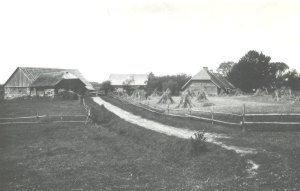
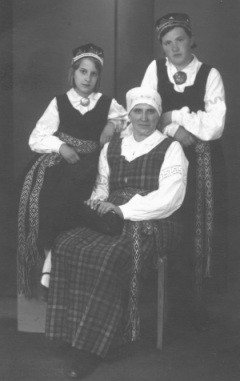
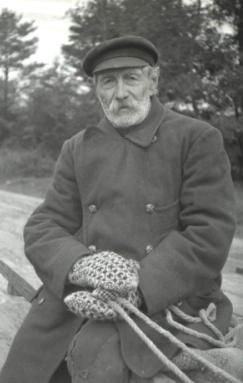
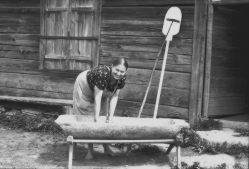
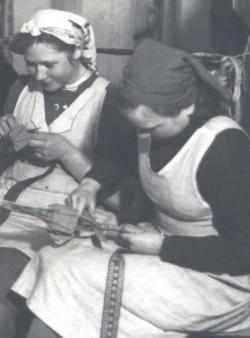
| DEPARTMENT OF ETHNOLOGY | |||||
Ethnology on this site:
|
|||||
|
|||||
Electronic publications on ethnologyPētījumi par nemateriālo kultūras mantojumu (Bulgārija - Latvija) / Studies of Intangible Cultural Heritage (Bulgaria - Latvia). [Rīga:] LU Latvijas vēstures institūts, 2013 - 179 lpp. (available at: http://www.lvi.lv/lv/elektropubl_files/Nematerialais_kulturas_mantojums_Intangible_Cultural_Heritage_2013.pdf) Books on ethnology published by "Zinātne"These books are on sale at the "Zinātne" bookshop in the Academy of Sciences building (Akadēmijas laukums 1, Riga) and in major bookstores in Latvia. 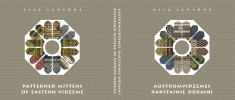 Jansone A. Patterned Mittens of Eastern Vidzeme. - Riga, Zinatne, 2014 - 215 p. This book is devoted to the patterned mittens of eastern Vidzeme from the second half of the 20th and the beginning of the 21st century (primary sources), reflecting the level of development of knitting skills in this particular period and area. The choice of the eastern Vidzeme region was determined by the material collected by the author in the course of ethnographic fieldwork in Ļaudona and Mētriena Parishes of Madona District (2007) and Kūkas and Varieši Parish of Krustpils County (2009), in the course of which 359 pairs of knitted mittens, gloves and socks were recorded. Out of this total corpus, this publication analyses more than 180 patterned mittens, which provide a picture of the course of development of knitters’ creative approaches in eastern Vidzeme in the second half of the 20th and the early 21st century, and the work they have produced. The tasks set in this work are: 1) to preserve the historical memory of the corpus of knitted patterned mittens from the second half of the 20th century and early 21st century; 2) to analyse the development of the knitting techniques, decoration and colour schemes of the mittens; 3) to outline the interaction between professional applied art and folk art in this sphere, identifying the causal relationships behind the developments. CONTENTS Introduction – 5 p. The development of mitten patterns – 7 p. The knitting of mittens – 16 p. The mitten cuff – 18 p. The patterns on mitten palms – 25 p. The mitten decrease – 31 p. The use of mittens – 31 p. Conclusions – 33 p. Endnotes – 35 p. Abbreviations – 36 p. Appendix – 37. p. 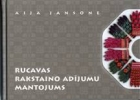 Jansone A. Heritage of Rucava’s Patterned Knitted Articles.– Riga, Zinātne, 2011- 200 p., il. Text in Latvian and English In the early 21st century a significant amount of traditional knitted articles, which are witnesses of their time, are kept in many of the houses in Rucava and in the local collections of significant ethnographic material. The task of the research is to demonstrate the historical development of the making, adorning and use of gloves and socks knitted in Rucava, providing a small retrospective insight into the material of the late 19th century and outlining the development trends of knitted items at the start of the 21st century. During the period of ethnographic expeditions of research between 2005-2008, the author of the research of Rucavas and Dunikas civil parish recorded 67 pairs of gloves, 85 – double gloves, 39 – mittens and 30 pairs of knitted socks and their sections (cuffs). Of the collection referred to, 191 photographic images and 25 drawings of patterns have been put into the publication, which was until now unpublished material of Rucavas knitted items. These knitted items are in the ownership of the Rucavnieki themselves, but their descriptions and photographic images are stored in the Ethnographic material collection of the Latvian Institute of History of the University of Latvia. CONTENTS Introduction – 7 p. Development of knitted article patterns – 11 p. Museum collections – 27 p. Glove and sock collection of the National History Museum of Latvia – 27 p. Collection of Rihards Zariņš (1909-1911) in the Russian Museum of Ethnography – 31 p. Collections of the scientific expeditions of ethnographers 2005-2008 – 37 p. Mittens and double gloves – 39 p. Glove shape – 39 p. Colour of knitted articles – 45 p. Patterns of mittens and double gloves – 49 p. Gloves – 57 p. Socks – 67 p. Present-giving traditions 77 p. Conclusions – 83 p. Abbreviations – 86 p. References and notes – 87 p. Annex/figures Double gloves - 95 p. Mittens – 137 p. Gloves – 149 p. Socks – 179 p. 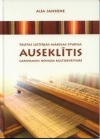 Jansone A. The role of the Auseklītis Folk Applied Art Studio in the cultural history of Carnikava County.- Riga, Zinatne, 2011- 94 p. In Latvian with summary in English. The work is about the contribution of the weavers and needleworkers of the Carnikava County Folk Applied Art Studio Auseklītis to the cultural history of the county. In its 46 years of existence, the studio’s activities have reflected Latvian tradition, contemporary influences and pan-human values. The history of the Auseklītis Studio goes back to 1965. Initially it was called the Applied Art Club , but in 1989 this club developed into the Auseklītis Folk Applied Art Studio, which has become well known in Latvia. Right from the beginnings of the group up to the present day, practically all the directions of activity of the weavers and needleworkers of Carnikava were established by the successive leaders of Auseklītis (Genija Drulle, Ārija Cekule and Zane Ulmane), based on their knowledge, experience and creative potential, but since Carnikava itself is located in the Vidzeme region, the works tend to emphasise the textile-making traditions and colour combinations characteristic of this particular cultural-historical region. CONTENTS Introduction – 7 p. The development of Folk Applied Art in Latvia and Folk Applied Art Studio „Auseklītis”– 9 p. History of the development of Folk Applied Art Studio „Auseklītis”.- 14 p. Folk Applied Art Studio „Auseklītis” in the last 20 years.- 36 p. Folk Applied Art Studio „Auseklītis” exhibition action.- 44 p. Successful Folk Applied Art Studio „Auseklītis” creative works.- 79 p. Conclusion. - 82 p. Folk Applied Art Studio „Auseklītis” members in 2010/11 season.- 83 p. Summary - 88 p. 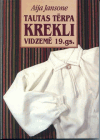 Jansone A. Tautas tērpa krekli Vidzemē 19. gs. [19 Century Shirts of the Traditional Folk Costume in the Vidzeme Region]. - Rīga: Zinātne, 1999. - 143 lpp., il., 2 lp. kr. il. In Latvian with summary in English. 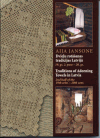 Jansone A. Dvieļu rotāšanas tradīcijas Latvijā. 19. gs. 2. puse – 20. gs. = Traditions of Adorning Towels in Latvia (2nd half of the 19th cent. – 20th cent.) - Rīga: Zinātne, 2001. - 131 lpp.. il. Text in Latvian and English. The book deals with the history of decorative towel embroidery in Latvia (19th-20th cent.). It is illustrated with documental photos from different places in Latvia. A tradition of making and adorning decorative towels, as well as towel end trimming is discussed on the background of historical development. Attention is paid to the traditions of using decorative towels, still widely spread in the everyday life of Latvian people. The book includes also a supplemental sheet of 94 photos of towels from scientific expeditions of the ethnographers of the Institute of History of Latvia. CONTENTS Ievads.- 5. lpp. Dvieļu darināšanas un lietošanas tradīcijas.- 7. lpp. Pūra dvieļi.-7. lpp. Bēru dvieļi.- 10. lpp. Dvieļu darināšana.- 11. lpp. Dvieļu galu apdare.- 18. lpp. Dvieļu izšuvumu motīvi un kompozīcija.- 23. lpp. Preface - 42 p. Traditions of Making and Using Towels - 44 p. Dowry Towels – 44 p. Coffin Towels – 47 p. The Process of Making Towels – 48 p. Trimming Towels Ends – 50 p. Motives and Compositions of Towels Embroideries – 54 p. Avoti un literatūras norādes. - 113. lpp. Sources and References - 113 p. Tekstā publicēto attēlu saraksti. - 117. lpp. Captions of Figures Published in the Text – 119 p. Attēlu saraksti pielikumā. - 121. lpp. Captions of Photoes Published in Supplementary Sheets – 125 p.  Jansone A. Decorated home textiles in Latvia. Late 19th – 20th century. - Rīga: Zinātne, 2004. - 227 p., il. Text in Latvian and English. This book is intended as a history of embroidery and needlework in Latvia in the late 19th and 20th century. Chapter 1 of the study relates the process of learning needlework techniques during the course of two centuries. Discussed from various aspects is the making of pattern samplers and organised training of embroidery in Latvia. Chapter 2 deals with decorated home textiles – interior textiles (tablecloths, towels, rugs, wall hangings and curtains). Chapter 3 describes bedclothes (sheets, bedspreads, pillowcases and cushions), the course of development of these textiles and their diversity in Latvia. CONTENTS Introduction – 9 p. I Chapter. Embroidery training in Latvia – 38 p. Making pattern samples – 38 p. Samples for white work – 39 p. Tule samples – 40 p. Samples for coloured motives – 40 p. Samples for filling stitches – 42 p. Designs drawn by hand – 42 p. Organised training of embroiderers – 43 p. Needlework shops – 43 p. Needlework literature – 45 p. Special schools – 47 p. Contemporary development in Latvia folk applied art – 51 p. II Chapter. Interior textiles – 97 p. Tablecloths – 97 p. White tablecloths – 98 p. Richelieu tablecloths – 99 p. Mats of commodes – 100 p. Crochet tablecloths – 100 p. Knit tablecloths – 100 p. Tablecloths sewn on a frame – 101 p. Coloured decorated tablecloths – 101 p. Coloured decorated mats – 101 p. Towels – 131 p. Trimming of towel ends and decoration of towels – 132 p. Motifs and composition of towel embroidery – 132 p. Rugs – 145 p. Wall hangings – 164 p. Curtains – 178 p. Living room curtains – 178 p. Door curtains – 179 p. Kitchen curtains – 179 p. III Chapter. Bedclothes – 198 p. Bed-sheets – 199 p. Bedspreads – 201 p. Pillows and cushion – 222 p. Conclusions – 227 p. 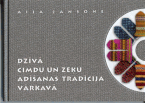 Jansone A. Glove and sock knitting tradition in Varkava. (2nd half of the 20th century- early 21st century). - Rīga: Zinātne, 2008 - 128 p., il. Text in Latvian and English. In the 20th – 21st centuries, of the Latvian traditional applied arts, knitting is the most widely produced genre of handicraft. To a great extent this is due to a relatively straightforward technique, readily available material and the suitability of knitted items for our climatic conditions. The material recorded in ethnographic collections in the 21st century mainly shows the latest cultural cross-sections of knit-work, i.e. pieces of work from the end of the 20th century and today. In Varkava, the tradition of “distributing the dowry” at weddings still exists; in one house a large dowry of 40 pairs of gloves was recorded, to be shared out to the groom’s relatives at the wedding. This entire dowry is published in this edition. The tradition of knitting patterned socks in Varkava is also noteworthy. The edition will analyse gloves and socks according to their use, materials utilised, techniques used and the composition of ornamental patterns and colours. CONTENTS Introduction – 5 p. Knitting in Vārkava – 12 p. References – 43 p. Dowry Gloves – 49 p. Mittens – 71 p. Mitten Series – 99 p. Gloves – 105 p. Socks – 111 p.  Jansone.A. Atkal dzimtenē. Aleksandras Dzērvītes mūža devums latviešu lietiškās mākslas attīstībā trimdā. [Back Home Again. Aleksandra Dzērvīte and the development of Latvian Crafts in Exile.]- Rīga, Zinātne, 2013. -167 lpp. Text in Latvian and English This publication is dedicated to the artist, craftswoman and teacher, Aleksandra Dzērvīte, who devoted her whole life to the cultivation of traditional Latvian folk art, the preservation of what is uniquely Latvian and handing it on to future generations. Contents Introduction - 7 I Family history (prepared by R. Kalniņa) - 10 II A. Dzērvīte’s creative work - 28 III A. Dzērvīte’s publications on applied arts - 42 IV A. Dzērvīte and Latvian folk costume - 56 V Krustpils-type shawls - 66 V.I. A. Dzērvīte’s sketches of shawls - 76 VI A. Dzērvīte’s original design composition sketches and notes - 94 VII Catalogue of A. Dzērvīte’s needlework - 100 VIII A. Dzērvīte’s manuscript “Needlework techniques” - 128 Conclusion - 158 A. Dzērvīte’s best-known publications - 160 Abbreviations - 167  Jansone.A. Krustpils villaines. Kultūrvēsturisks pētījums par izšūtajām Krustpils tipa villainēm Austrumlatvijā (18.gs. beigas – 19. gs. pirmā puse). [Krustpils-type villaines. A cultural Historical research on embroidered Krustpils-type villaines in Eastern Latvia. (Late 18th – first half of the19th century).] - Rīga, Zinātne, 2012. -263 lpp. In Latvian with summary in English. The book is about white shawls decorated with embroidery and tablet-woven bands dating from the end of the 18th and the first half of the 19th century – the Krustpilstype villaines. The author has identified practically all the Krustpils-type villaines from the first half of the 19th century that are preserved up to the present day in museum collections in Latvia, as well as material collected in various periods and with various levels of knowledge: 1) material evidence (the collections of Latvian museums); 2) written sources (material of the Board of Monuments, the Atlas of Latvian Culture and the Repository of Ethnographic Material of the Institute of Latvian History at the University of Latvia); 3) iconographic material (drawings by J. C. Brotze, reconstruction drawings of villaines by the Board of Monuments); 4) private collections (sketches of villaines by A. Dzērvīte); 5) literature. Analysed in the work is the development of the Krustpils-type villaine across time and space, from a morphological perspective (the set of garments constituting dress, and individual garments) and from an artistic-stylistic perspective (raw material, designs, composition, decorative techniques and colour). Its place in the European cultural space is outlined, identifying similarities to textiles of other peoples, showing their development and changes in the cut of dress and ornamentation under the influence of the age and fashion. CONTENTS Introduction - 6 I Sources and literature - 8 II The history of unsewn shawls – villaines – and their distribution in Latvia - 38 III Iespējamie Krustpils tipa villaiņu prototipi - 43 IV Forms of shawls in Latvia - 50 V The names for shawls - 61 VI Analysis of the characteristics of shawls - 73 Conclusions - 98 Summary - 102 Appendix - 110 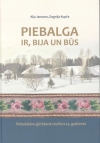 Aija Jansone, Dagnija Kupče. Piebalga is, was and will be. Dressing culture in Piebalga during the 19th century. Vēverīšas, Cēsis. 2014., p. 183. Dressing culture in Piebalga during the 19th century is the first interdisciplinary scientific and practical study in the cultural history of Latvia that supplements our knowledge of the development of clothing in Piebalga. Respecting the totality of generations of experience and the addition of unpublished sources, the chronological framework of the research is established on the basis of the sources. The materials are viewed in the context of processes in Europe at that time and systematically analysed using comparative-historical methodology and retrospective methodology, i.e., reconstruction and collections from ethnographic field trips. The 19th century in Europe was a time of great changes: industrialisation develops; there is continuous change in styles of art (the Empire style of the 1830s–1840s is replaced by Biedermeier, which in turn is followed by Impressionism and Jugendstil1). These changes undeniably influenced the dressing culture of the ordinary people of Piebalga. Everything that was new in the city reached the rural workers through the manor house, tradesmen and market centres. Fashion ideas also spread like this. Old items of clothing were either replaced by new ones, or became additions to costume. Part I of this book “Sources and literature” provides an analysis of material evidence (objects preserved in museums), written sources (recorded information), drawings of Piebalga clothing from the late 18th and early 19th century, as well as specialist literature. Part II “Clothing fabrics in Piebalga” looks at the creation and variety of short and wide clothing textiles. Part III “Women’s clothing in Piebalga” presents a chronological view of the development of women’s garments of particular time periods. Part IV “Men’s clothing in Piebalga” shows the diversity of outfits and components, with emphasis being placed on the development of cut and patterns. Content Introduction - 7 I Sources and literature - 11 Exhibits sources - 12 Written and visual sources - 14 Literature - 22 II Clothing fabrics - 33 Narrow woven fabrics - 38 The wide garment fabrics - 40 Shirt fabrics - 40 Trouser fabrics - 41 Skirt fabrics - 42 Apron fabrics - 49 Shoulder quilt fabrics - 50 Home woven scarves - 52 Handkerchief fabrics - 52 Coat fabrics - 53 Sheepskin coat - 54 III Women's clothing - 57 Clothing sets - 59 Women's shirts - 62 Skirts - 67 Shawls - 78 Headgears - 85 Overdress - 96 Jackets and corsages - 96 Aprons - 97 Handkerchiefs - 99 Socks, shoes - 100 19th century. second-hand suits, dresses and lingerie - 103 Underskirt - 106 Gloves and mittens - 107 19th century. second half of the women's clothing reconstruction - 111 IV Men's Clothing in Piebalga - 129 Shirt - 130 Men's outerwear - 132 Jacket - 133 Overcoats (mēteļi) - 137 Fur coats - 138 Knee-length jacket - 140 The short jacket - 143 Waistcoats - 144 Neckerchiefs - 145 Trousers - 146 Hand and foot wear - 149 Men's headgear - 151 19th century. Piebalgas men's clothing reconstruction - 155 Conclusions - 159 Piebalga is, was and will be. Summary - 163 Appendix. Shirts - 169 |
|||||